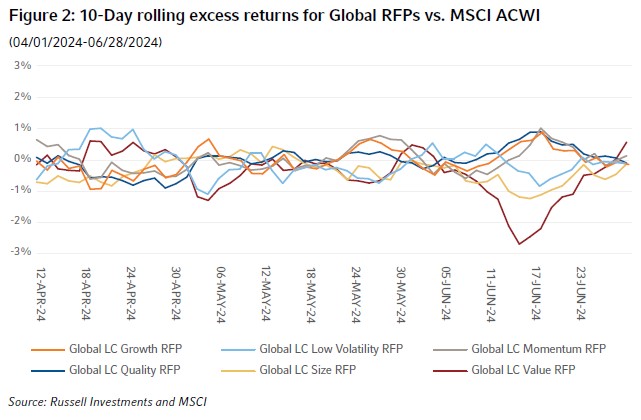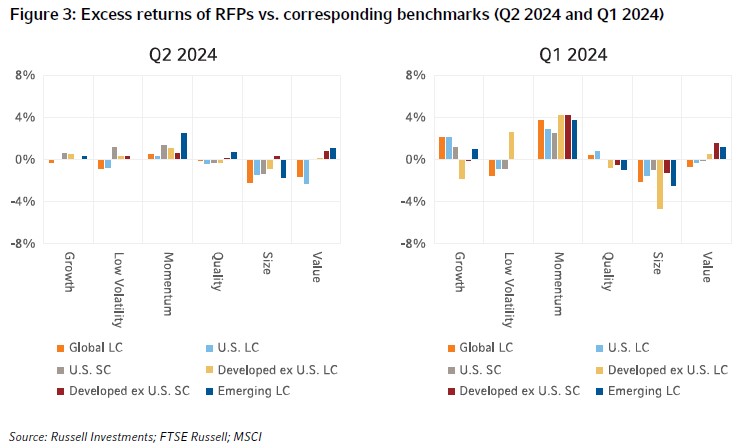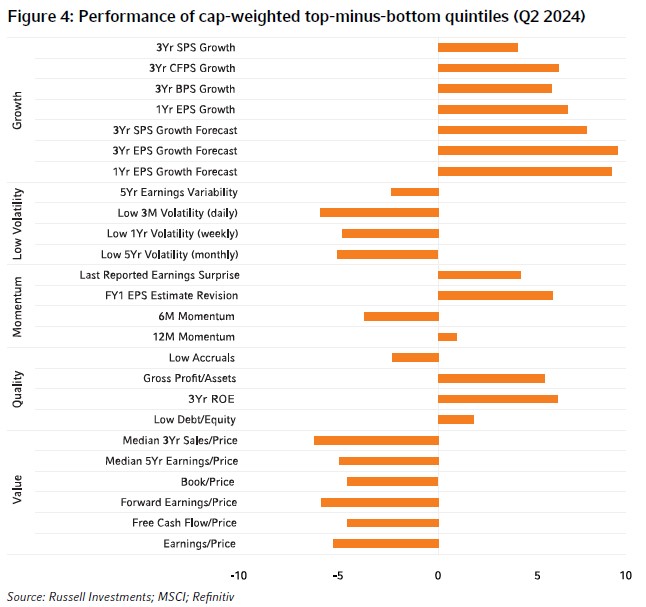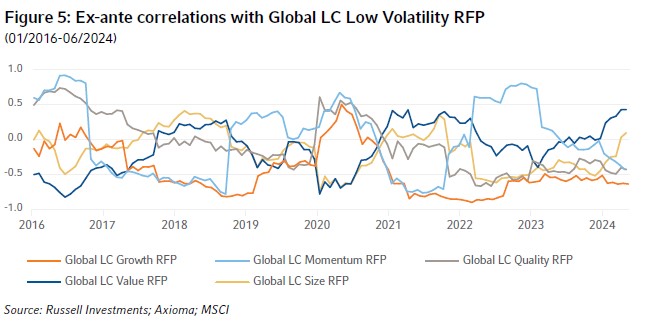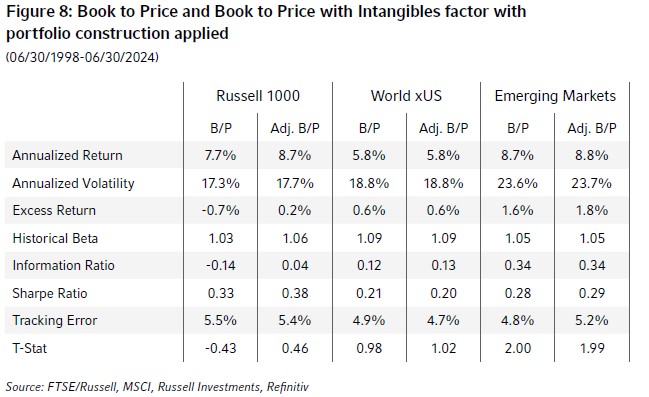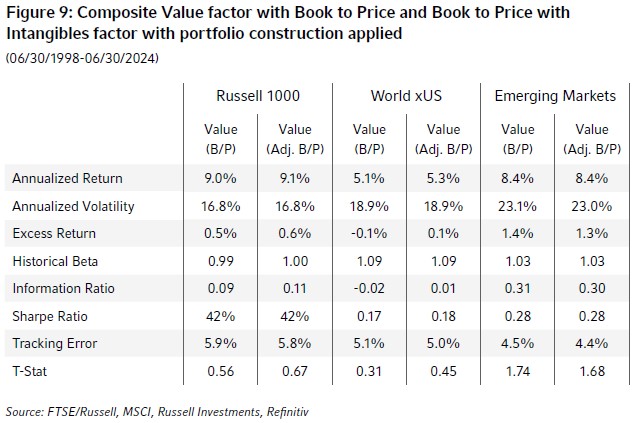Executive summary:
- The Momentum factor strongly outperformed across all regions in the second quarter while the Size factor underperformed.
- Among Russell Investments' Factor Portfolios (RFPs), Global Large Cap Momentum outperformed the MSCI ACWI while Global Large Cap Quality and Growth portfolios were relatively flat. Conversely, Global Large Cap Size, Value, and Low Volatility portfolios underperformed.
- In the MSCI ACWI universe, all Growth subfactors outperformed in Q2 while all Value and Low Volatility subfactors underperformed.
Overview
Concerns over a slowing economy and labor market at the beginning of the quarter firmed investors’ beliefs that interest rate cuts were on the way as the MSCI All Country World Index (ACWI) shook off a sluggish start to the quarter to finish with a gain of 3%. The Russell 1000 Index performed in a similar fashion, with negative returns at the beginning of the quarter but a +3.6% return by the end. The Russell 1000 index was not able to outpace the MSCI Emerging Markets Index, which had a higher return of +5.1% for the quarter while the MSCI World ex-U.S. Index had a negative return of -0.4%.
When considering Russell Investments’ global factor portfolios (RFPs), only Global Large Cap Momentum outperformed the benchmark this quarter with positive excess returns of +0.6%. The Global Large Cap Quality and Growth portfolios started the quarter underperforming the benchmark but reversed that trend as the quarter progressed to end the quarter relatively flat with excess returns of -0.1% and -0.2%, respectively. Conversely, the Global Large Cap Size, Value, and Low Volatility portfolios underperformed, with negative excess returns of -2.2%, -1.8%, -0.9%.
Factor Performance
Global Russell Investments Factor Portfolios’ performance dynamics
The performance dispersion among Global Russell Factor Portfolios (RFPs) this quarter was quite small for most of the quarter with deviations from the benchmark staying within a range of +/- 1%. Value had a strong period of underperformance at the beginning of June before recovering to recoup some of those losses to finish the quarter.
Russell Investments Factor Portfolios’ performance across regions
In the second quarter of 2024, the performance of the factor portfolios across regions was very similar to the prior quarter.The Momentum factor strongly outperformed, while the Size factor continues to underperform across all regions. The U.S. Large Cap and Emerging Markets diverged within the Value factor, with Emerging Markets Value outperforming by +1.5% while U.S. Large Cap underperformed by -2.5%. We see a similar outcome within Quality for the same regions, with Emerging Markets Quality outperforming by 0.8% while U.S. Large Cap underperformed by -0.4%. Size had very similar outcomes for the quarter across all regions with underperformance against the respective benchmarks ranging from -1% to -2.2% with Developed ex-U.S. Small Cap as the lone exception where we observe an outperformance of +0.3%. The strongest performance among factors was seen in Emerging Markets, where Momentum outperformed by +2.3%. The weakest performance among factors was in U.S. Large Cap, where the Value factor underperformed (-2.5%).
Performance of subfactors in the global universe
Figure 4 below illustrates the performance of various subfactors in the MSCI ACWI universe for the last quarter, represented by top minus bottom quintile portfolios.1 All Value subfactors had a negative return in Q2, continuing a trend from the prior quarter. All Low Volatility subfactors had a negative return as well, with 3-month daily volatility having the largest negative return of -5.91%. The performance of all Growth subfactors was strongly positive with 3-Year EPS Growth forecast having the best performance for the quarter with a robust 9% return. Interestingly, the performance of the Momentum subfactors was somewhat mixed with analyst-measured factors, Last Reported Earnings Surprise and FY1 EPS Estimate Revisions, performing strongly with returns of 4.2% and 5.8%, respectively. The returns-based Momentum factors did not perform as well with 12-month Momentum having a return of 0.9% and 6-month Momentum having a negative return of -3.7%. Quality subfactors were also mixed with all factors having a positive return with the exception of accruals.
Ex-ante correlations and active risk of Global Russell Investments Factor Portfolios
In the second quarter, we saw a continued rise in correlations between the Value factor and Low Volatility, as illustrated in Figure 5 below. The trend between Size and Low Volatility continues to increase though it is still at very weak levels. Momentum has shifted from being strongly correlated in 2023 to being uncorrelated at the end of Q2. The remaining factor correlations have remained stable, with Growth and Quality showing no significant changes and staying uncorrelated. Ex-ante active risk levels—predictive measures of the active risk associated with factor portfolios in Figure 6— showed no significant changes in Q2 and maintain a normal level in the active riskiness of these portfolios.
Spotlight on: Evaluating the Value factor with adjustments to Book Value using intangible assets
Much has been written about the underperformance of the Value factor, with many concluding that traditional measures of book value are no longer relevant or that it is missing crucial pieces of information such as intangible assets. Intangible assets tend to be more pronounced for sectors such as technology and healthcare and might not fully capture the value of future earnings on investments in the traditional measure of book value. Here we explore adjusting book value by adding back intangible assets, specifically research and development expenses and selling, general and administrative expenses, and test whether it provides a better outcome for the Value factor.
We first look at the difference between book value and adjusted book value (with an intangibles adjustment) in a long-short context. Figure 7 displays the annualized top minus bottom quintile returns of the Russell 1000, MSCI World ex-U.S. and MSCI Emerging Markets indexes for both factors. We see that adding intangible assets to the definition of value increases the return on a long-short basis. The biggest improvement was in the U.S. where the returns increased by +2.3%, followed by World ex-U.S. (+1.3%) and Emerging Markets (+0.7%).
Intuitively this makes sense. Within the U.S., firms follow Generally Accepted Accounting Principles (GAAP), which apply a different methodology in calculating book value than firms that apply International Financial Reporting Standards (IFRS). Within GAAP, expenses incurred in generating intangible assets such as patents and copyrights are expensed when incurred but in IFRS, part of those expenses can be capitalized on the balance sheet and additive to book value. This difference causes reported book values to be more inclusive of intangible assets for firms reporting in IFRS than GAAP, resulting in smaller adjustment amounts.
Next, we apply a long-only constraint and apply Russell Investments’ portfolio construction on book to price (B/P) and adjusted book to price (Adj. B/P) factors. Figure 8 shows the summarized results for U.S., World ex-U.S. and Emerging Markets portfolios. Adjusted book value continues to provide a higher return for the U.S. and Emerging Markets regions but is flat within World ex-U.S. when compared to just book to price alone. The magnitude of the improvement for adjusted book value is smaller than those observed in the long-short quintile portfolios.
Finally, we create a composite value factor that includes book to price and adjusted book to price factors, along with Earnings to Price, Cash Flow to Price, Forward Earnings to Price, Median 3-year Sales to Price and Median 5-year Earnings to Price. Combining components to create a composite factor offers a comprehensive view of value that takes advantage of diversification benefits from different measures of value.
When evaluating the adjustment to book value when applied to a composite factor, the observed premium using single factor portfolio construction is further diluted to a smaller amount. Within the Russell 1000 value factor, the 95-basis-point improvement from the single factor definition is reduced to only 11 basis points. Interestingly, within World ex-U.S., this excess return increases when using adjusted book to price compared to the single factor. In Emerging Markets, the excess return drops to a small 5-basis-point improvement when including intangible assets vs. the traditional measure of book to price.
We observe the improvement in performance noted in academic literature2 by including intangible assets and the improved premium is persistent when applied in a long-only context, though less robust in regions outside the U.S. When intangible assets are added in the context of a comprehensive value definition, the premium is diluted. As noted above, the impact of intangibles is more dramatic within the U.S. due to the differences in accounting standards and is more impactful in some sectors, mainly technology and healthcare, than others. Further research into the impacts of the sector-level shifts in adjusting book value would be useful in evaluating the efficacy of including intangible assets.
The bottom line
- When considering intangibles in calculating book value, we see an improvement in performance within the factor. However, when considering portfolio construction that includes a diversified compositive value definition, we only see marginal improvement.
- The Momentum and Growth factors continue to perform well with all subfactors outperforming in Growth, while subfactor performance in Momentum was mixed. All Value and Low Volatility subfactors underperformed.
- Correlation between the Global LC Value and Low Volatility RFPs continues to increase, while the correlation between Global LC Momentum and Low Volatility RFPs firmly shifted from being strongly correlated in 2023 to uncorrelated.
1 Top minus bottom cap-weighted quintile portfolios are not investible and are used to proxy the performance of the subfactors used in the construction of RFPs. RFPs are long only portfolios.
2 Li, Feifei, Intangibles: The Missing Ingredient in Book Value (2021). SSRN & Amenc, Noel, Goltz, Feliz and Luyten, Ben, “Intangible Capital and the Value Factor: Has Your Value Definition Just Expired?, The Journal of Portfolio Management, July 2020



